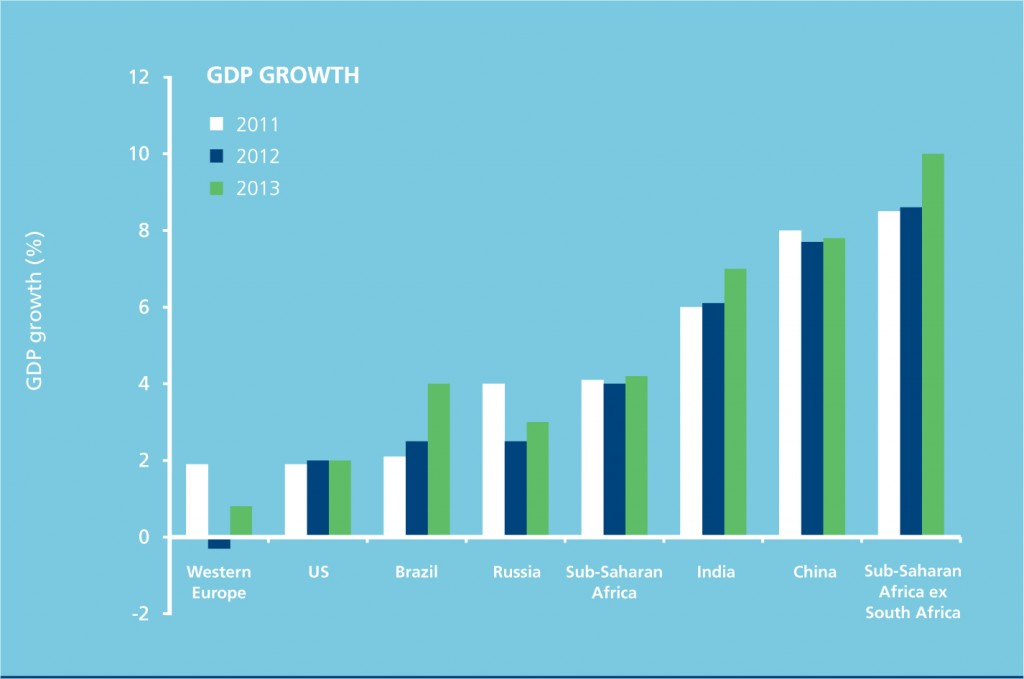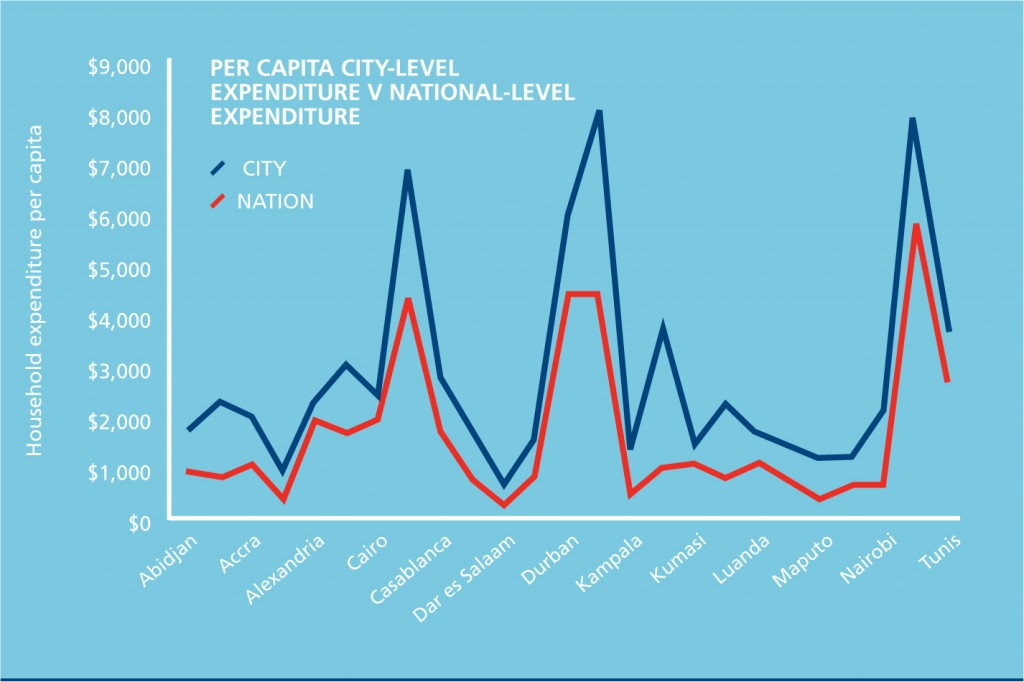A survey by The Economist Intelligence Unit (EIU) of 217 global companies based in 45 countries shows that expansion in Africa is a priority for two-thirds of them over the next decade.
In the recent past, companies looking to expand into Africa have targeted countries with huge natural resources and/or impressive GDP growth. Now companies are also concentrating their strategies on where population growth and demographics are the most favourable – in major cities.
They know it is not enough to plan a strategy around nationally forecasted growth, but rather to have critical forecasting and business information on particular locations.
EIU has therefore identified opportunities for growth among 25 African cities, across 19 countries, based on economic drivers, such as income and expenditure, cost of living indices and lifestyle indicators.
The upshot is that data from the key cities – what the EIU calls ‘Africa cities rising’ – paints a different picture from the one investors may previously have perceived. Nations may ‘paint a picture’ overall of stereotypical poverty, whereas their key cities may bring considerable opportunities for investment.
One finding illustrates that viewpoint: per capita expenditure is higher in each of the 25 key cities identified, by the EIU, than in their respective nations (as might be expected given that vast swathes of African populations have moved away from impoverished country locations to cities to seek economic benefits). But their actual economic worth is quite astonishing – citizens in the key cities spend 94.4% more, per capita, than their countrymen as a whole.
The pace of urbanisation in these African cities is increasing and key cities are attracting more and more migrants – more and more potential consumers of mobile banking, food outlets, cars, phones…
As a result, says the EIU, the world is witnessing the emergence of ‘super African cities’ where the demographic profile is in sharp contrast to the demographic profile elsewhere in the same country.
The key cities identified in the EIU report are shown on the map below together with EIU’s national GDP growth forecasts for 2012-2016:
This graph shows the per capita ‘super city’ expenditure compared with the national-level expenditure.
And, we’ve heard it before, but it is worth emphasising that eight of the world’s 20 fastest-growing economies (albeit from a low base) have been African in the period 2011-2013.
See barchart:
 But investors can most benefit by examining and comparing individual cities in detail to assess prospects for their goods and services. Cities like Nairobi and Mombasa (Kenya) and Addis Ababa (Ethiopia) have a glut of their populations in the 20-35 age demographic; while the biggest growth in population as a whole from 2012-2025 will be in Kampala (Uganda), Dar es Salaam (Tanzania) and Lusaka (Zambia).
But investors can most benefit by examining and comparing individual cities in detail to assess prospects for their goods and services. Cities like Nairobi and Mombasa (Kenya) and Addis Ababa (Ethiopia) have a glut of their populations in the 20-35 age demographic; while the biggest growth in population as a whole from 2012-2025 will be in Kampala (Uganda), Dar es Salaam (Tanzania) and Lusaka (Zambia).
Expenditure per capita differs markedly across the key cities identified, depending on the product in question. Leading the table for expenditure on alcoholic beverages and tobacco, for example, is Johannesburg, followed by Cape Town and Durban (South Africa). Abuja (Nigeria) has the least expenditure on these products. Leading the table for expenditure on transport is Tripoli (Lybia), followed by Johannesburg and Cape Town. Lusaka has the least expenditure on this service.
Overall official cost of living (rather than on the black market) is most expensive in Luanda (Angola), followed by Abuja and Abidjan (Cote d’Ivoire). The lowest cost of living is in Addis Ababa. When products and services are assessed in the cost of living index, Khartoum (Republic of Sudan) rates as most expensive for alcoholic beverages, tobacco and narcotics; Abidjan the most expensive for transport.
Forecasting demand for products and services is never straightforward – political stability, local labour skills, wage levels and so on all come into play. But benchmarking African key cities is another valuable piece to the jigsaw – and, prospectively, may become the most important as demographics, lifestyle values and rewards start to plateau across African cities as a whole (regardless of their inequalities with the remainder of their countries), corruption is increasingly outlawed (albeit far from eradicated), and political regimes become more predictable.
Pro-Africa investors talk of the ‘wind of change’ sweeping across the continent as democracy replaces armed conflict and military rule. That may take a few more decades. Greater accountability, they say, arrives hand-in-hand with democracy and the slow strengthening of institutions. That may come too, over time.
Europe is still Africa’s largest trading partner, and populations still have an unspoken allegiance to the cultures of
European former colonial powers, while tolerating the explosion of Chinese investment in infrastructure which has brought them jobs and cash. That may change, as decades pass.
Potholed roads, clogged traffic, inadequate rail networks, inefficient border posts, congested ports, uninviting airports… African cities have them all, and they won’t disappear overnight.
But what is less debatable, quite undeniable, are the opportunities created by data that shows half of all Africans are under the age of 20 and that they are rapidly moving to cities. More than 40% of Africans now live in urban areas, while the number of mobile subscribers in Africa exceeded the 0.5 billion mark as far back as 2010, allowing greater access to the consumers of tomorrow.
“The pace of urbanisation in these African cities is increasing and key cities are attracting more and more migrants – more and more potential consumers of mobile banking, food outlets, cars, phones…“
UHY member firms have business centres in several key city locations. For the full list see: www.uhy.com
Africa will be the main source of world population growth until at least the middle of this century, according to forecasts by the Population Reference Bureau, US. The present African population of 1.1 billion is expected to more than double to 2.4 billion by 2050 as a result of better healthcare and fewer babies dying in childbirth or in their early years.
While the world population is set to reach 9.7 billion (up from today’s 7.1 billion) by 2050, according to the French Institute of Demographic Studies, a BBC2 documentary in the UK, ‘Don’t panic: the truth about population’, contends that the longer-term trend is population stability or decline, as women in developing countries will give birth to fewer children – about half their current number of offspring.




